CADILLAC CATERA 1998 1.G Owners Manual
Manufacturer: CADILLAC, Model Year: 1998, Model line: CATERA, Model: CADILLAC CATERA 1998 1.GPages: 346, PDF Size: 19.13 MB
Page 261 of 346
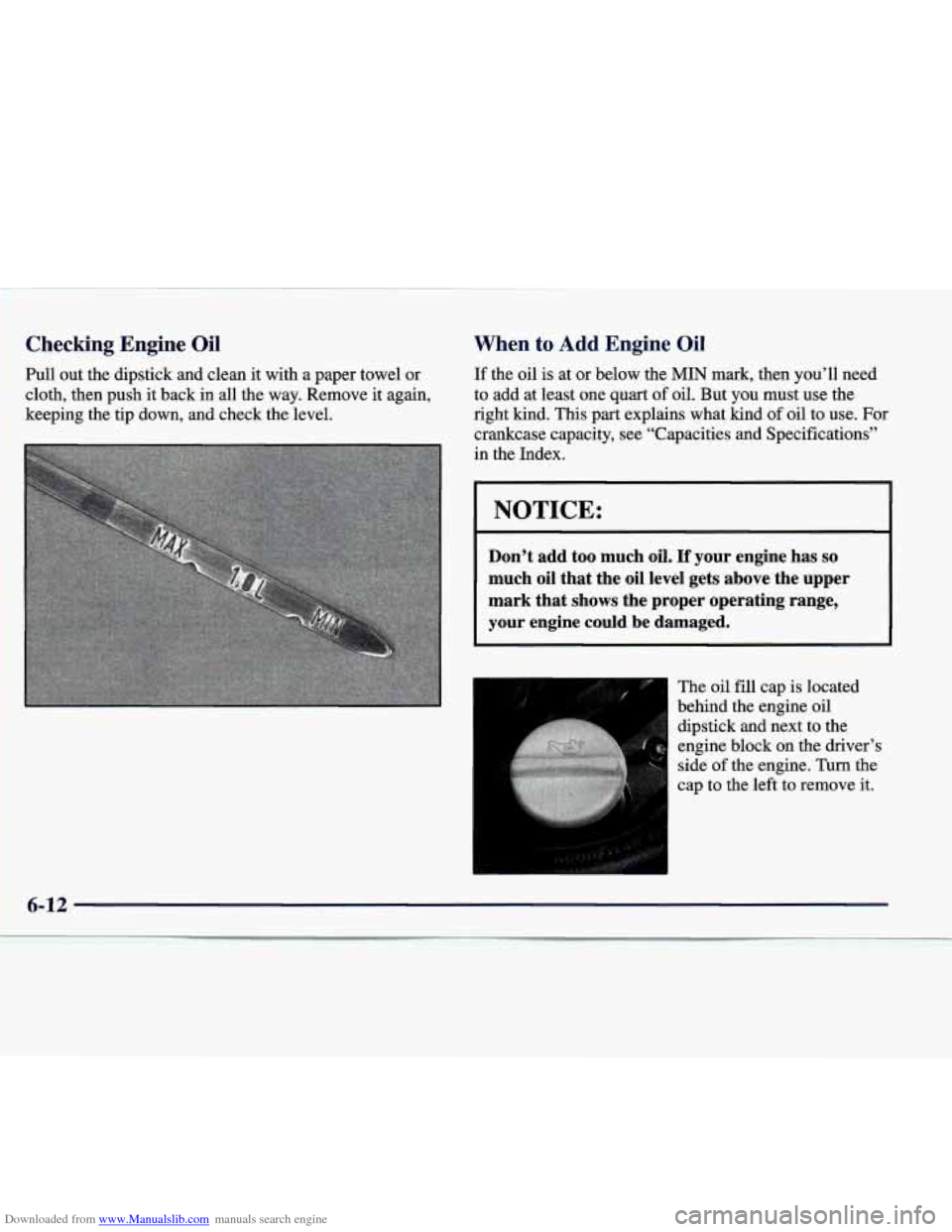
Downloaded from www.Manualslib.com manuals search engine Checking Engine Oil
Pull out the dipstick and clean it with a paper towel or
cloth, then push it back in all the way. Remove it again,
keeping the tip down, and check the level.
When to Add Engine Oil
If the oil is at or below the MIN mark, then you’ll need
to add at least one quart
of oil. But you must use the
right kind. This part explains what kind
of oil to use. For
crankcase capacity, see “Capacities and Specifications”
in the Index.
NOTICE:
Don’t add too much oil. If your engine has so
much oil that the oil level gets above the upper
mark that shows the proper operating range,
your engine could be damaged.
The oil fill cap is located
behind the engine oil
dipstick and next to the
engine block on the driver’s
side
of the engine. Turn the
cap to the left to remove
it.
6-12
Page 262 of 346
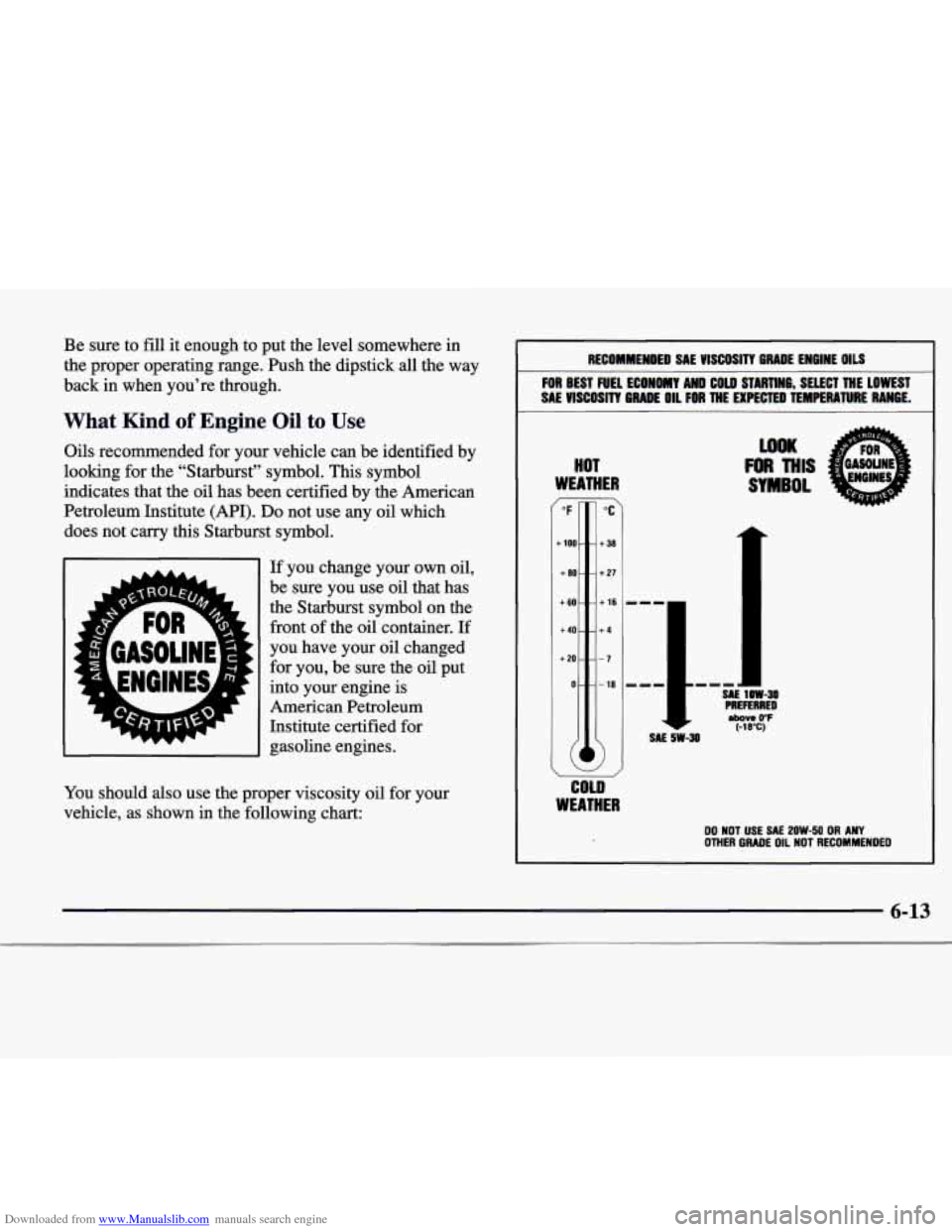
Downloaded from www.Manualslib.com manuals search engine Be sure to fill it enough to put the level somewhere in
the proper operating range. Push the dipstick
all the way
back in when you’re through.
What Kind of Engine Oil to Use
Oils recommended for your vehicle can be identified by
looking for the “Starburst” symbol. This symbol
indicates that the oil has been certified by the American
Petroleum Institute
(API). Do not use any oil which
does not carry this Starburst symbol.
If you change your own oil,
be sure you use oil that has
the Starburst symbol on the
front of the
oil container. If
you have your oil changed
for you, be sure the
oil put
into your engine is
American Petroleum
Institute certified for
gasoline engines.
You should also use the proper viscosity oil for your
vehicle, as shown in the following chart:
RECOMHEHDED SAE VISCOSITY GRADE ENGINE OILS
FOR BEST FUEL ECONOMY AND COW STARTING, SELECT THE LOWEST
SAE
VISCOSITY GRADE OIL FOR THE EXPECTED TEMPERATURE RANGE.
HOT
WEATHER
“F
t 100
+ 80
t60.
t40.
t20.
0.
(
i
“C
t 38
t 27
t 16
t4
-7
- 18
SAE sw-30
,I SAE I lOW-30
PREFERRED above 0°F (-18°C)
WOK
FI)R THIS
SYMBOL
u
COLD
WEATHER
DO NOT USE SAE 2OW-50 OR ANY OTHER GRADE OIL NOT RECOMMENDED
6-13
Page 263 of 346
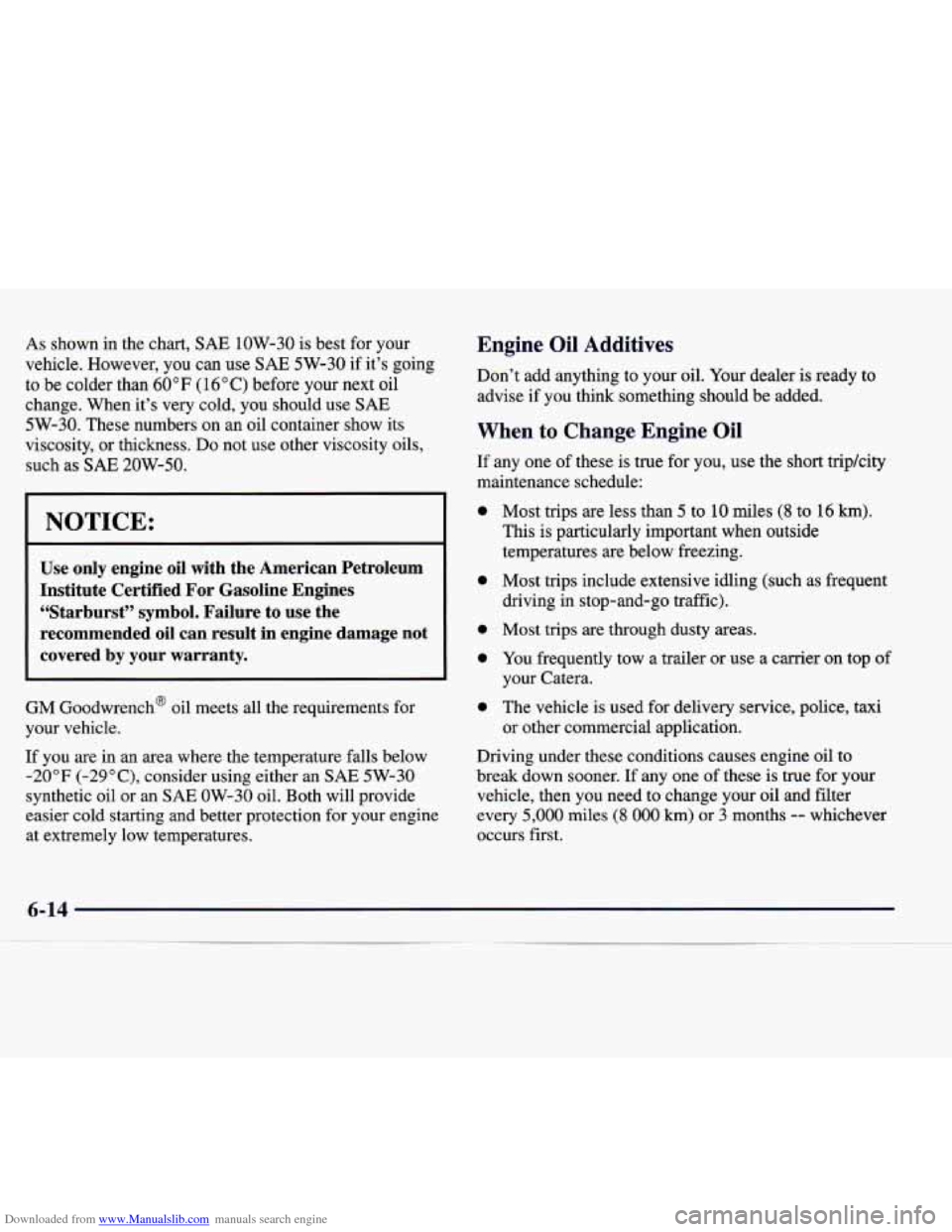
Downloaded from www.Manualslib.com manuals search engine As shown in the chart, SAE 1OW-30 is best for your
vehicle. However, you
can use SAE 5W-30 if it’s going
to be colder than
60 OF (1 6 O C) before your next oil
change. When it’s very cold, you should use
SAE
5W-30. These numbers on an oil container show its
viscosity, or thickness.
Do not use other viscosity oils,
such as
SAE 20W-50.
NOTICE:
Use only engine oil with the American Petroleum
Institute Certified For Gasoline Engines
“Starburst” symbol. Failure to use the
recommended oil can result in engine damage not
covered by your warranty.
GM Goodwrench@ oil meets all the requirements for
your vehicle.
If you are in an area where the temperature falls below
-20°F (-29”C), consider using either an
SAE 5W-30
synthetic oil or an
SAE OW-30 oil. Both will provide
easier cold starting and better protection for your engine
at extremely low temperatures.
Engine Oil Additives
Don’t add anything to your oil. Your dealer is ready to
advise
if you think something should be added.
When to Change Engine Oil
If any one of these is true for you, use the short tripkity
maintenance schedule:
0
0
0
0
0
Most trips are less than 5 to 10 miles (8 to 16 km).
This is particularly important when outside
temperatures
are below freezing.
Most trips include extensive idling (such as frequent driving in stop-and-go traffic).
Most trips are through dusty areas.
You frequently tow a trailer
or use a carrier on top of
your Catera.
The vehicle is used for delivery service, police, taxi
or other commercial application.
Driving under these conditions causes engine oil
to
break down sooner. If any one of these is true for your
vehicle, then you need to change your oil and filter
every
5,000 miles (8 000 km) or 3 months -- whichever
occurs first.
Page 264 of 346
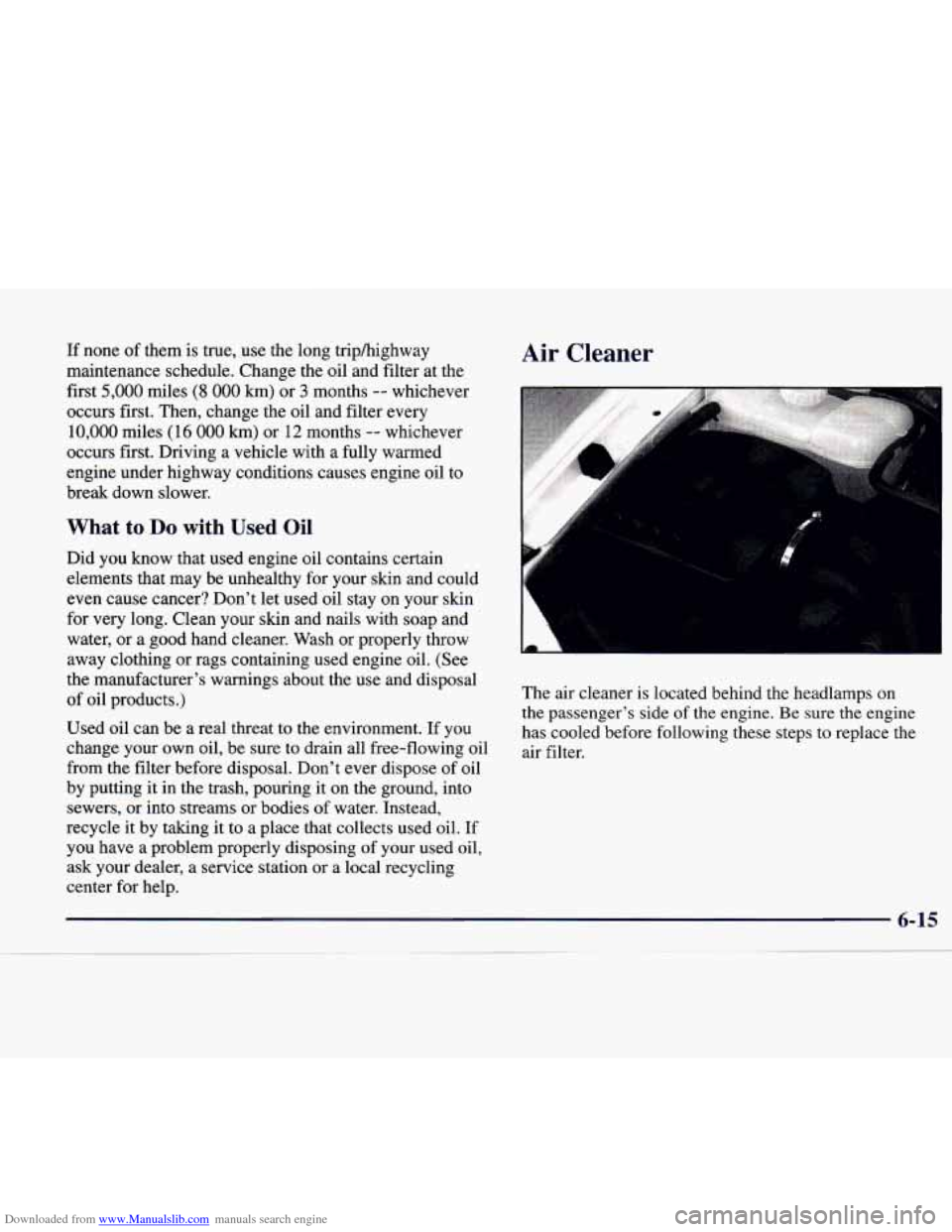
Downloaded from www.Manualslib.com manuals search engine If none of them is true, use the long triphighway
maintenance schedule. Change the oil and filter at the
first
5,000 miles (8 000 km) or 3 months -- whichever
occurs first. Then, change the oil and filter every
10,000 miles (16 000 km) or 12 months -- whichever
occurs first. Driving a vehicle with a fully warmed
engine under highway conditions causes engine oil to
break down slower.
What to Do with Used Oil
Did you know that used engine oil contains certain
elements that may be unhealthy for your skin and could
even cause cancer? Don't let used oil stay on your skin
for very long. Clean your skin and
nails with soap and
water, or a good hand cleaner. Wash or properly throw
away clothing or rags containing used engine oil. (See
the manufacturer's warnings about the use and disposal
of oil products.)
Air Cleaner
The air cleaner is located behind the headlamps on
the passenger's side
of the engine. Be sure the engine
has cooled before following these steps to replace the
air filter.
Used
oil can be a real threat to the environment. If you
change your own oil, be sure to drain all free-flowing oil
from the filter before disposal. Don't ever dispose of oil
by putting it
in the trash, pouring it on the ground, into
sewers,
or into streams or bodies of water. Instead,
recycle
it by taking it to a place that collects used oil. If
you have a problem properly disposing
of your used oil,
ask your dealer, a service station or a local recycling
center for help.
6-15
Page 265 of 346
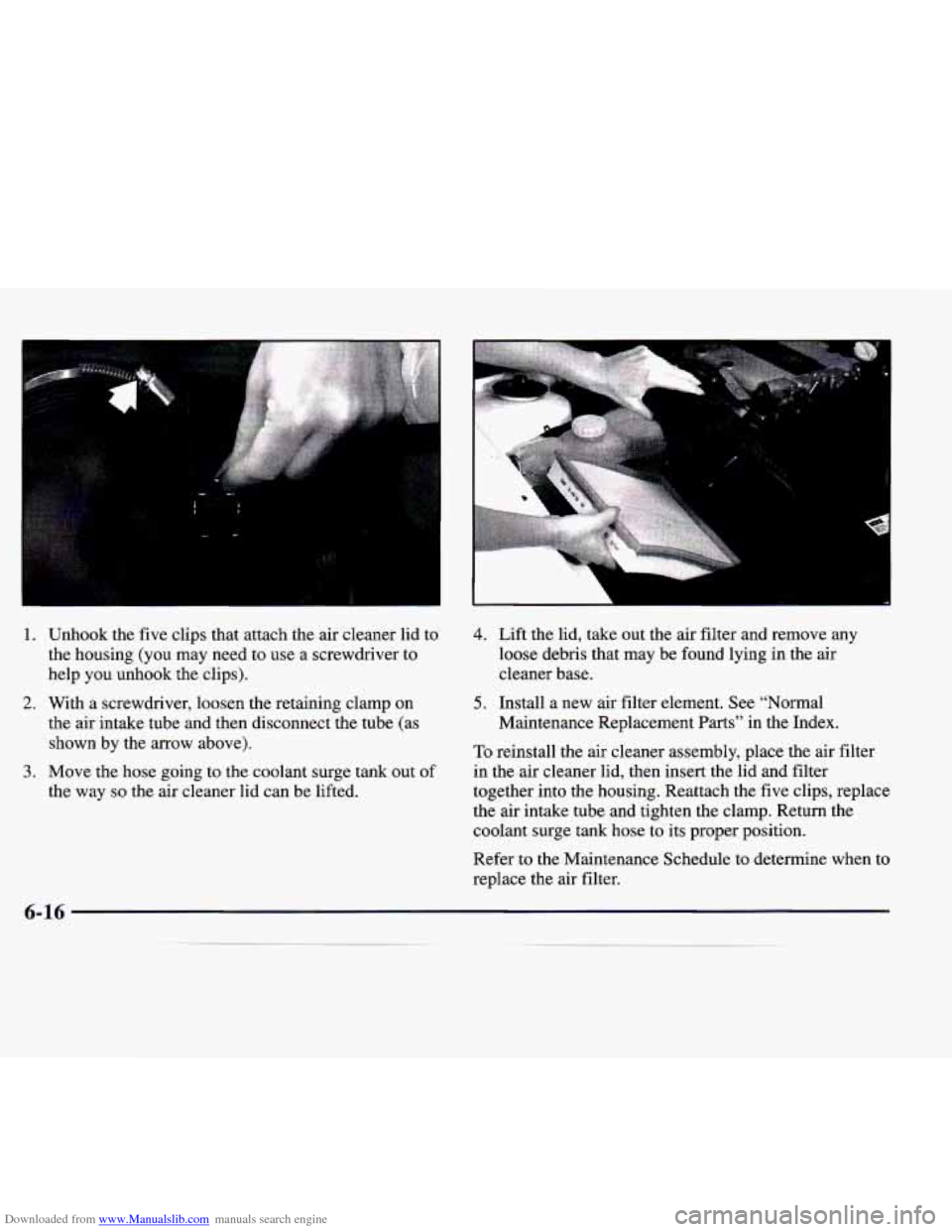
Downloaded from www.Manualslib.com manuals search engine I
r- I 1 L
1. Unhook the five clips that attach the air cleaner lid to
the housing (you may need to use a screwdriver to
help
you unhook the clips).
2. With a screwdriver, loosen the retaining clamp on
the air intake tube and then disconnect the tube (as
shown by the arrow above).
the way
so the air cleaner lid can be lifted.
3. Move the hose going to the coolant surge tank out of
4. Lift the lid, take out [ne air filter and remove any
loose debris that may be found lying in the air
cleaner base.
5. Install a new air filter element. See “Normal
Maintenance Replacement
Parts” in the Index.
To reinstall the air cleaner assembly, place the air filter
in the air cleaner lid, then insert the lid and filter
together into the housing. Reattach the five clips, replace
the air intake tube and tighten the clamp. Return the
coolant surge tank hose to its proper position.
Refer
to the Maintenance Schedule to determine when to
replace the air filter.
Page 266 of 346
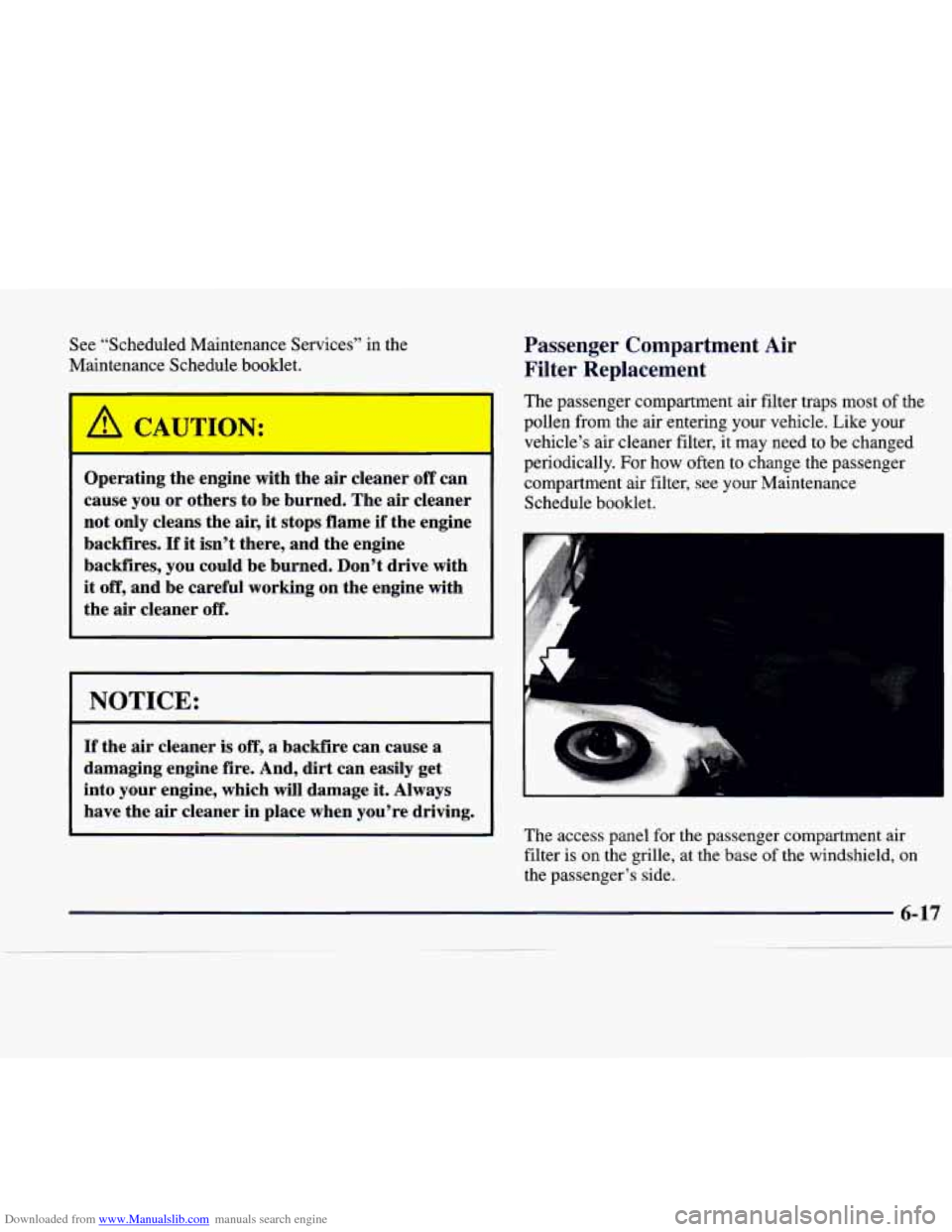
Downloaded from www.Manualslib.com manuals search engine See “Scheduled Maintenance Services” in the
Maintenance Schedule booklet.
Operating the engine with the air cleaner off can
cause you or others
to be burned. The air cleaner
not only cleans the air, it stops flame if the engine
backfires.
If it isn’t there, and the engine
backfires,
you could be burned. Don’t drive with
it off, and be careful working on the engine with
the air cleaner
off.
NOTICE: I
If the air cleaner is off, a bachfire can cause a
damaging engine fire. And, dirt can easily get
into your engine, which will damage it. Always
have the air cleaner in place when you’re driving.
Passenger Compartment Air
Filter Replacement
The passenger compartment air filter traps most of the
pollen from the air entering your vehicle. Like your
vehicle’s air cleaner filter, it may need to be changed periodically. For
how often to change the passenger
compartment air filter, see your Maintenance
Schedule booklet.
B
The access panel for the passenger compartment air
filter
is on the grille, at the base of the windshield, on
the passenger’s side.
Page 267 of 346
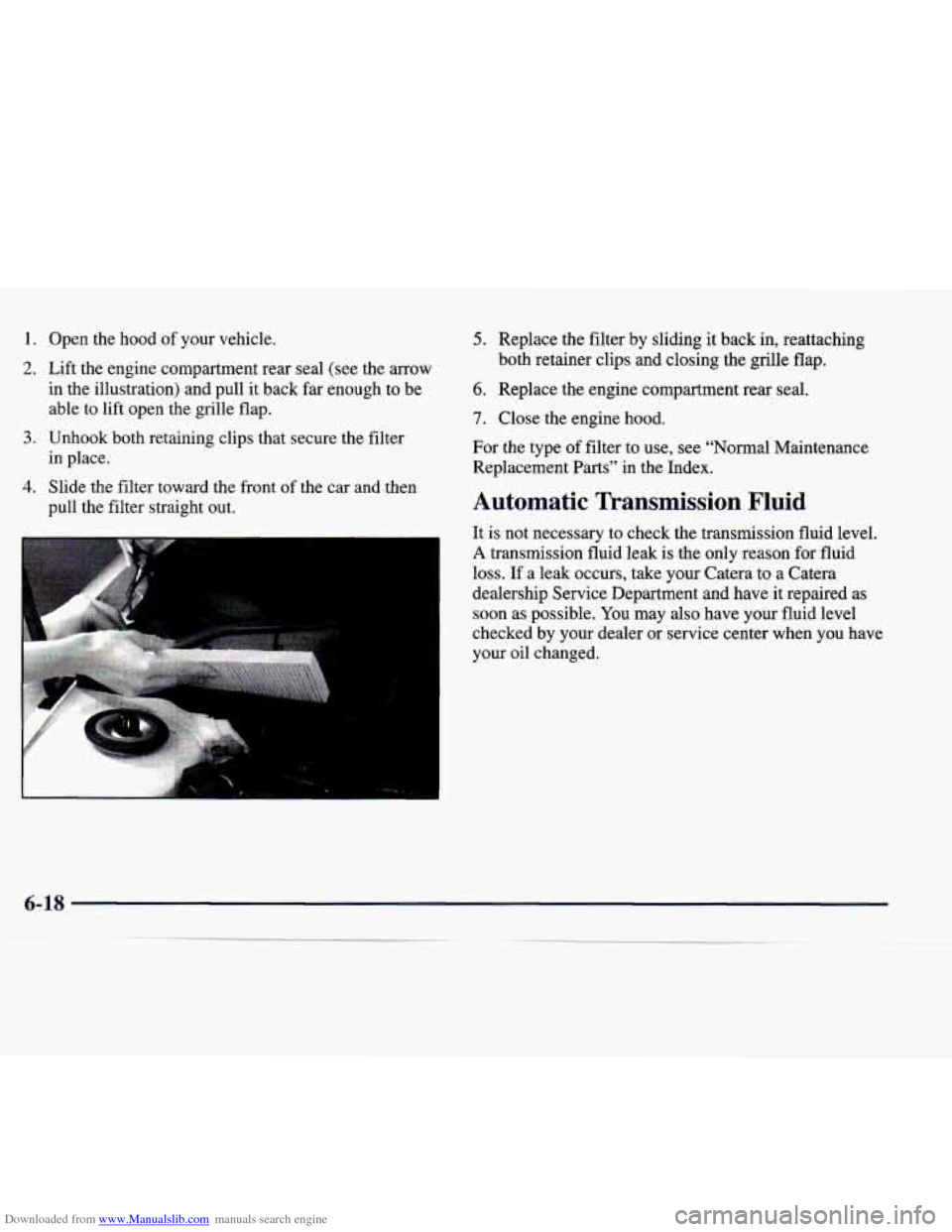
Downloaded from www.Manualslib.com manuals search engine 1. Open the hood of your vehicle.
2. Lift the engine compartment rear seal (see the arrow
in the illustration) and pull it back far enough to be
able to lift open the grille flap.
in place.
pull the filter straight out.
3. Unhook both retaining clips that secure the filter
4. Slide the filter toward the front of the car and then
5. Replace the filter by sliding it back in, reattaching
6. Replace the engine compartment rear seal.
7. Close the engine hood.
both retainer clips and closing the grille flap.
For the type of filter to use, see “Normal Maintenance
Replacement Parts” in the Index.
Automatic Transmissio~ Fluid
It is not necessary to check the transmission fluid level.
A transmission fluid leak is the only reason for fluid
loss. If a leak occurs, take your Catera to
a Catera
dealership Service Department and have it repaired as
soon as possible. You may
also have your fluid level
checked by your dealer
or service center when you have
your oil changed.
Page 268 of 346
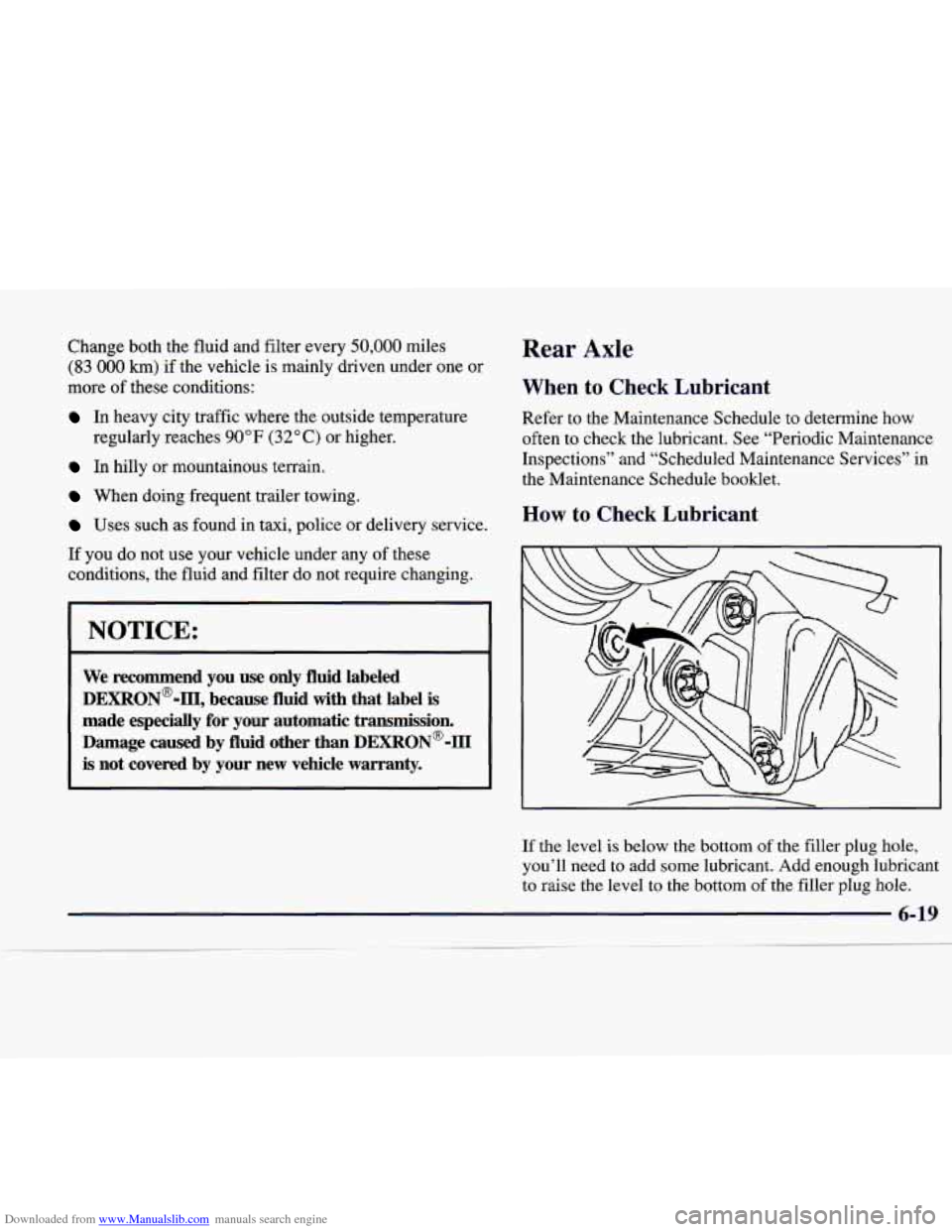
Downloaded from www.Manualslib.com manuals search engine Change both the fluid and filter every 50,000 miles
(83 000 km) if the vehicle is mainly driven under one or
more
of these conditions:
In heavy city traffic where the outside temperature
In hilly or mountainous terrain.
When doing frequent trailer towing.
Uses such as found in taxi, police or delivery service.
If you do not use your vehicle under any of these
conditions, the fluid and filter do not require changing.
regularly
reaches
90” F (32” C) or higher.
NOTICE:
We recommend you use only fluid labeled
DEXRON@-m, because fluid with that label
is
made especially for your automatic transmission.
Damage
caused by fluid other than DEXRON@-III
is not covered by your new vehicle warranty.
Rear Axle
When to Check Lubricant
Refer to the Maintenance Schedule to determine how
often to check the lubricant. See “Periodic Maintenance
Inspections” and “Scheduled Maintenance Services” in
the Maintenance Schedule booklet.
How to Check Lubricant
If the level is below the bottom of the filler plug hole,
you’ll need to add some lubricant. Add enough lubricant
to raise the level to the bottom of the filler plug hole.
Page 269 of 346
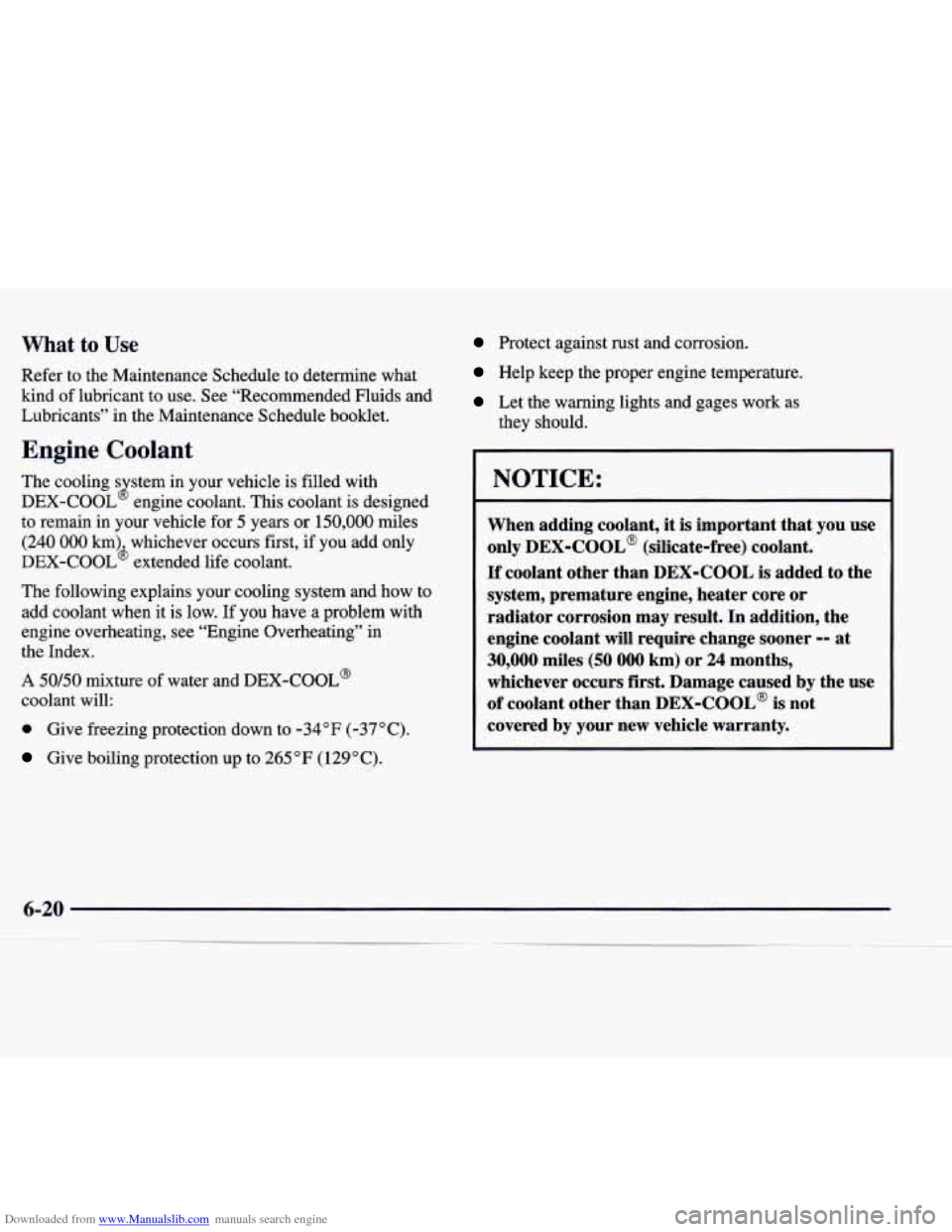
Downloaded from www.Manualslib.com manuals search engine What to Use
Refer to the Maintenance Schedule to determine what
kind of lubricant to use. See “Recommended Fluids and
Lubricants” in the Maintenance Schedule booklet.
Engine Coolant
The cooling s stem in your vehicle is filled with
DEX-COOL engine coolant.
This coolant is designed
to remain in your vehicle for
5 years or 150,000 miles
(240 000 krnb whichever occurs first, if you add only
DEX-COOL extended life coolant.
J
The following explains your cooling system and how to
add coolant when it is low. If you have
a problem with
engine overheating, see “Engine Overheating” in
the Index.
A 50/50 mixture of water and DEX-COOL’
coolant will:
a Give freezing protection down to -34°F (-37°C).
Give boiling protection up to 265 OF (129°C).
Protect against rust and corrosion.
Help keep the proper engine temperature.
Let the warning lights and gages work as
they should.
NOTICE:
When adding coolant, it is important that you use
only
DEX-COOL@ (silicate-free) coolant.
If coolant other than DEX-COOL is added to the
system, premature engine, heater core or
radiator corrosion may result. In addition, the
engine coolant
will require change sooner -- at
30,000 miles (50 000 km) or 24 months,
whichever occurs
first. Damage caused by the use
of coolant other than DEX-COOL@
is not
covered
by your new vehicle warranty.
6-20
-
Page 270 of 346
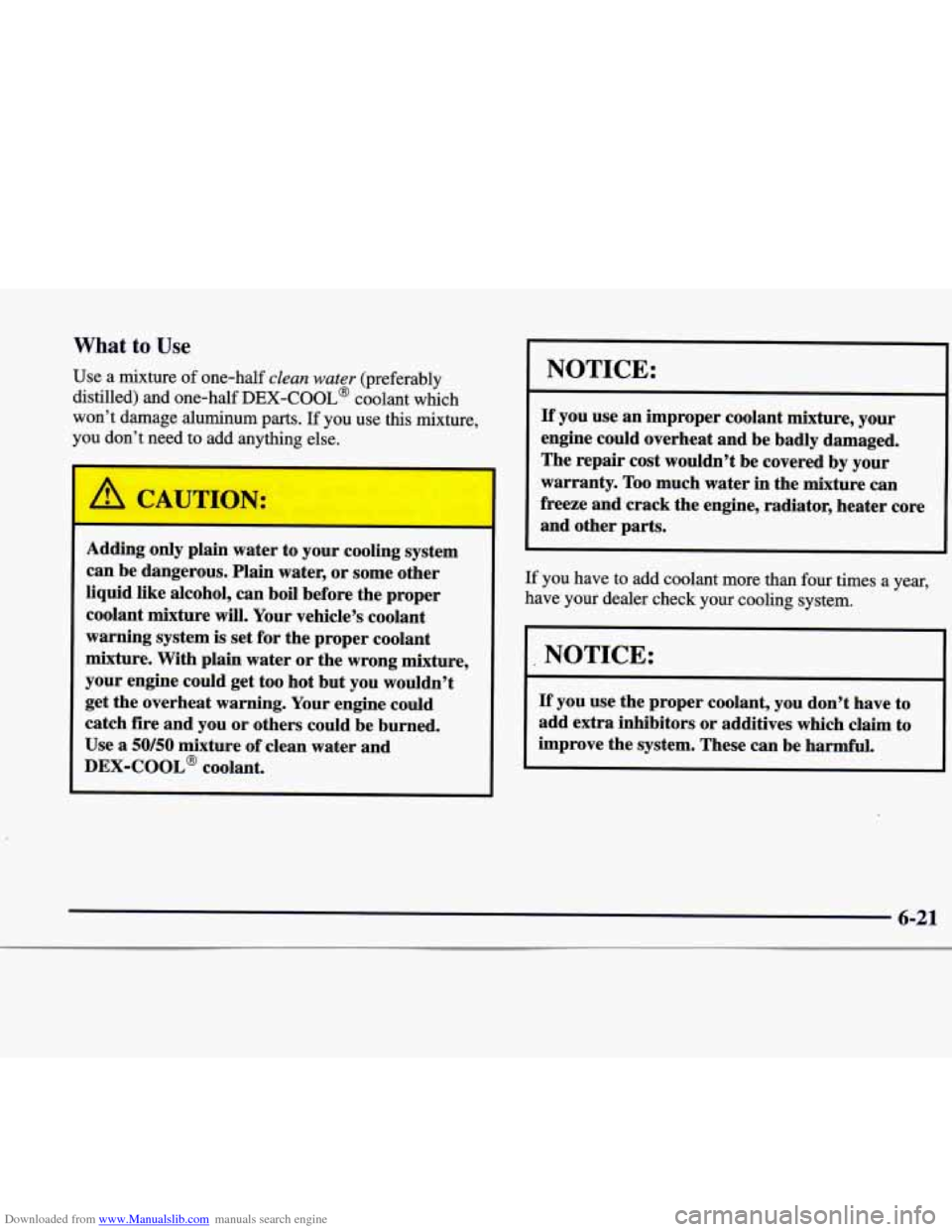
Downloaded from www.Manualslib.com manuals search engine What to Use
Use a mixture of one-half clean water (preferably
distilled) and one-half
DEX-COOL@ coolant which
won’t damage aluminum parts.
If you use this mixture,
you don’t need to add anything else.
Adding only plain water to your cooling system
can be dangerous. Plain water, or some other
liquid like alcohol, can boil before the proper
coolant mixture will. Your vehicle’s coolant
warning system
is set for the proper coolant
mixture. With plain water or the wrong mixture,
your engine could get too hot but you wouldn’t
get the overheat warning. Your engine could
catch fire and you or others could be burned.
Use
a 50/50 mixture of clean water and
DEX-COOL@ coolant.
NOTICE:
If you use an improper coolant mixture, your
engine could overheat and be badly damaged.
The repair cost wouldn’t be covered by your
warranty. Too much water
in the mixture can
freeze and crack the engine, radiator, heater core
and other parts.
If you have to add coolant more than four times a year,
have your dealer check your cooling system.
NOTICE:
If you use the proper coolant, you don’t have to
add extra inhibitors or additives which claim to
improve the system. These can be harmful.
6-21